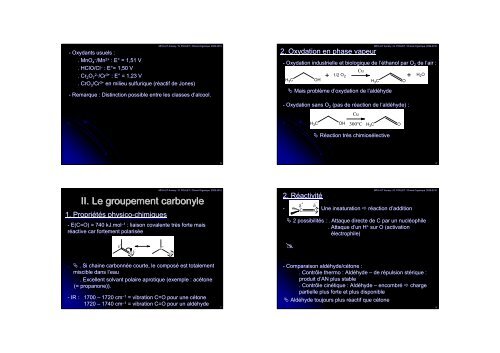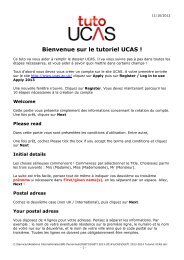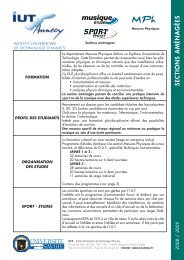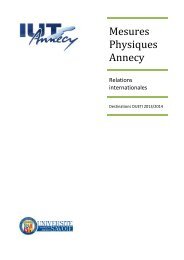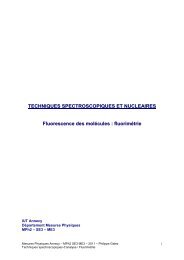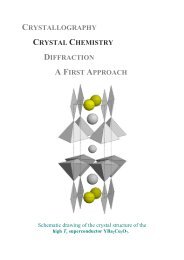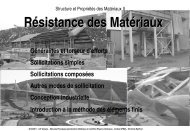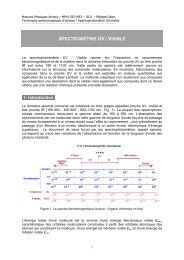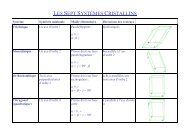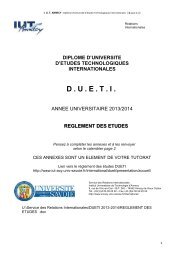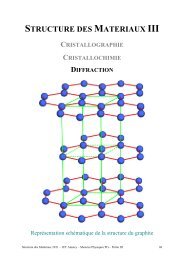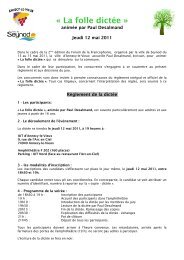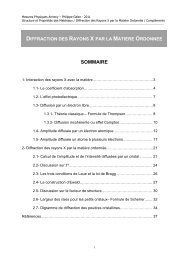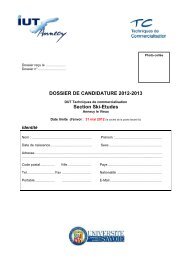Cours Module Complémentaire de Chimie Organique - IUT Annecy
Cours Module Complémentaire de Chimie Organique - IUT Annecy
Cours Module Complémentaire de Chimie Organique - IUT Annecy
Create successful ePaper yourself
Turn your PDF publications into a flip-book with our unique Google optimized e-Paper software.
MPH-<strong>IUT</strong> <strong>Annecy</strong> / G. POULET / <strong>Chimie</strong> <strong>Organique</strong> 2009-2010<br />
2010<br />
- Oxydants usuels :<br />
. MnO 4– /Mn 2+ : E° E = 1,51 V<br />
. HClO/Cl<br />
– : E°= E = 1,50 V<br />
. Cr 2 O<br />
2–<br />
7 /Cr 3+ : E° E = 1,23 V<br />
. CrO 3 /Cr 3+ en milieu sulfurique (réactif <strong>de</strong> Jones)<br />
- Remarque : Distinction possible entre les classes d’alcool. d<br />
2. Oxydation en phase vapeur<br />
MPH-<strong>IUT</strong> <strong>Annecy</strong> / G. POULET / <strong>Chimie</strong> <strong>Organique</strong> 2009-2010<br />
2010<br />
- Oxydation industrielle et biologique <strong>de</strong> l’él<br />
’éthanol par O 2 <strong>de</strong> l’air l<br />
:<br />
+ 1/2 O 2<br />
H 3 C OH<br />
Cu<br />
C H 3<br />
Mais problème d’oxydation d<br />
<strong>de</strong> l’aldl<br />
aldéhy<strong>de</strong><br />
- Oxydation sans O 2 (pas <strong>de</strong> réaction r<br />
<strong>de</strong> l’aldl<br />
aldéhy<strong>de</strong>) :<br />
Cu<br />
H 3 C OH 300°C H 3 C<br />
O<br />
+<br />
H 2 O<br />
O<br />
Réaction très chimiosélective<br />
5<br />
6<br />
MPH-<strong>IUT</strong> <strong>Annecy</strong> / G. POULET / <strong>Chimie</strong> <strong>Organique</strong> 2009-2010<br />
2010<br />
II. Le groupement carbonyle<br />
1. Propriétés s physico-chimiques<br />
chimiques<br />
- E(C=O) = 740 kJ.mol – 1 : liaison covalente très s forte mais<br />
réactive car fortement polarisée<br />
δ +<br />
δ −<br />
O<br />
C + O -<br />
2. RéactivitR<br />
activité<br />
δ +<br />
δ −<br />
MPH-<strong>IUT</strong> <strong>Annecy</strong> / G. POULET / <strong>Chimie</strong> <strong>Organique</strong> 2009-2010<br />
2010<br />
- C O Une insaturation réaction d’addition d<br />
2 possibilités s : . Attaque directe <strong>de</strong> C par un nucléophile<br />
. Attaque d’un d<br />
H + sur O (activation<br />
électrophile)<br />
<br />
. Si chaine carbonnée courte, le composé est totalement<br />
miscible dans l’eaul<br />
. Excellent solvant polaire aprotique (exemple : acétone<br />
(= propanone)).<br />
- IR : 1700 – 1720 cm – 1 = vibration C=O pour une cétone c<br />
1720 – 1740 cm – 1 = vibration C=O pour un aldéhy<strong>de</strong><br />
7<br />
- Comparaison aldéhy<strong>de</strong>/c<br />
hy<strong>de</strong>/cétone :<br />
. Contrôle thermo : Aldéhy<strong>de</strong><br />
– <strong>de</strong> répulsion r<br />
stérique :<br />
produit d’AN d<br />
plus stable<br />
. Contrôle cinétique : Aldéhy<strong>de</strong><br />
– encombré charge<br />
partielle plus forte et plus disponible<br />
Aldéhy<strong>de</strong> toujours plus réactif r<br />
que cétonec<br />
8


